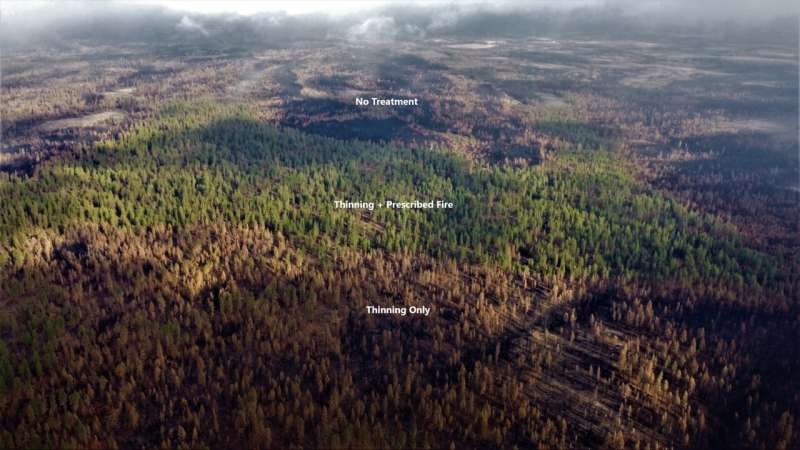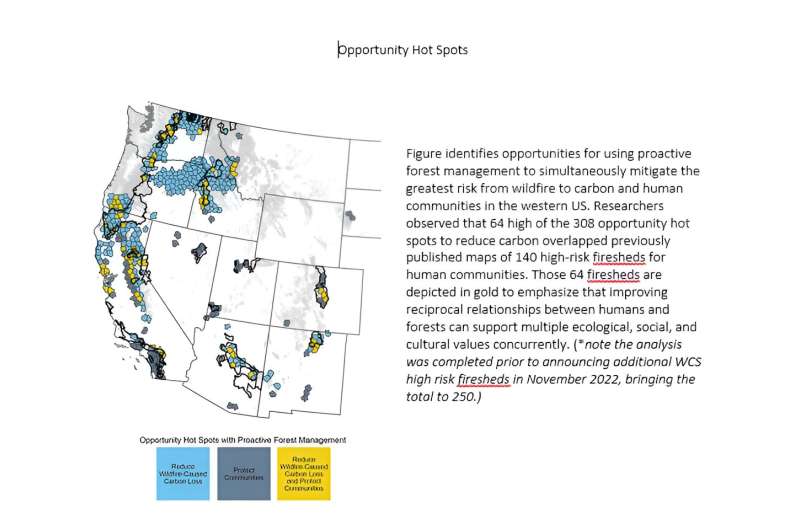This article has been reviewed according to Science X's editorial process and policies. Editors have highlighted the following attributes while ensuring the content's credibility:
fact-checked
peer-reviewed publication
trusted source
proofread
New research highlights opportunities to protect carbon and communities from forest fires

As the climate and wildfire crises have intensified, so too have concerns regarding the loss of carbon captured and stored in forests from decades to centuries of tree growth. A new study describes where to optimize ongoing wildfire mitigation efforts and reduce carbon loss due to wildfire, benefitting communities and climate at the same time.
New research
published in the journal Environmental Research Letters highlights widespread "opportunity
The study, a collaboration among The Nature Conservancy, University of Montana, and USDA Forest Service, evaluated where living trees and the carbon they store are at risk of burning in the future. They then compared these areas to areas highlighted in the Forest Service's Wildfire Crisis Strategy, identifying where human communities most vulnerable to wildfire. Areas of overlap highlight "opportunity hot spots" where action can reduce the risk from wildfire to both carbon and communities.
"Our approach can help land management agencies plan where to invest in proactive forest treatments that simultaneously reduce wildfire-caused carbon loss and protect communities from wildfire," says the study's lead author, Jamie Peeler, landscape ecologist and NatureNet Postdoctoral Science Fellow with the University of Montana. "It also could be applied to reduce risk from wildfire to other important values such as municipal water, culturally important plants, recreation, and wildlife habitat."

USDA Forest Service Chief Randy Moore added, "This type of science collaboration strengthens our efforts to support land managers in designing and implementing effective projects with multiple benefits, making good work even better. It also is key in informing our overall efforts to address the wildfire crisis facing our nation's forests by doing the right work, in the right place, at the right time."
During a wildfire, most carbon loss occurs when litter, duff, and downed woody material is consumed by the fire—but over time, trees killed during a fire decompose, producing another source of carbon loss. The study identifies locations where communities and agencies can consider implementing proactive forest management to reduce negative impacts from wildfires, including carbon loss.
Proactive forest management can reduce the number of trees killed in wildfires by reducing excess fuels, reducing the negative impacts of a century of fire suppression and global warming. It also can keep more living trees on the landscape after wildfire, to continue to capture and store carbon from the atmosphere and provide seeds for future forest.
"The need for proactive forest management in California, New Mexico and Arizona is particularly urgent, given that a large portion of their forested area is highly vulnerable to wildfire-caused carbon loss," says the study's co-author, Travis Woolley, forest ecologist for The Nature Conservancy in Arizona.
"As governments take action to address the escalating climate and wildfire crises, they do not need to choose between climate- and wildfire-mitigation goals," says Kerry Metlen, senior forest scientist for The Nature Conservancy in Oregon. "In the western US, opportunities are widespread to achieve both objectives with strategically placed proactive forest management."
More information: Jamie L Peeler et al, Identifying opportunity hot spots for reducing the risk of wildfire-caused carbon loss in western US conifer forests, Environmental Research Letters (2023). DOI: 10.1088/1748-9326/acf05a
Journal information: Environmental Research Letters
Provided by USDA Forest Service




















